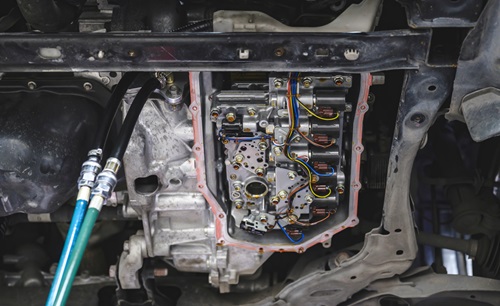Have you ever wondered why your car seems to have a case of the shivers when the temperature drops? Well, buckle up because we’re diving into the nitty-gritty of what causes transmission slip in cold weather. It’s like our cars catch a case of the chills, and suddenly shifting gears feels more like an icy dance move than a smooth operation. In this article, we’ll unravel the mystery behind why transmissions decide to take a winter vacation from their usual seamless performance. So, grab a warm cup of coffee, get cozy, and let’s warm up to the idea of understanding why our trusty rides might be slipping and sliding in chilly weather.
Outline
Toggle How to Tell Transmission is Slipping?
How to Tell Transmission is Slipping?
- Delayed or rough shifting between gears.
- Unusual RPM fluctuations while accelerating.
- Surges or lurches during gear changes.
- Difficulty staying in gear or unexpected disengagement.
- Overheating transmission fluid.
- Unusual noises like whining or clunking.
- Burnt or discolored transmission fluid.
- Warning lights on the dashboard, specifically the transmission or check engine light.
- Sudden loss of power or acceleration inconsistency.
Winter Weather & Your Transmission
Winter weather can be a real challenge for your vehicle’s transmission. As temperatures drop, the transmission fluid tends to thicken, making it more difficult for the gears to function smoothly. This can result in delayed or rough shifting, causing your car to feel like it’s struggling to find the right gear. Additionally, cold weather can lead to increased friction and wear on transmission components, potentially accelerating the usual wear and tear. It’s crucial to keep an eye on your transmission fluid levels and quality during the winter months, as low temperatures may cause fluid to contract and result in insufficient lubrication. Regular maintenance, such as fluid checks and warming up your vehicle before hitting the road, can go a long way in ensuring your transmission weathers the winter chill without slipping into performance issues.
Why Transmission Slips in Cold Weather?
- Fluid Viscosity Changes: Cold weather causes transmission fluid to thicken, increasing its viscosity. This thickening can impede the fluid’s ability to flow smoothly, making it more challenging for the transmission to engage and shift gears seamlessly.
- Delayed Response: The thickened fluid takes longer to reach critical components within the transmission, leading to delayed responses when you accelerate or attempt to shift gears. This delay can result in a noticeable lag or hesitation in the transmission’s performance.
- Friction and Wear: Cold temperatures can intensify friction between moving parts in the transmission. This increased friction accelerates wear on the transmission components, affecting their overall efficiency and contributing to slipping issues.
- Seal Contraction: Seals and gaskets in the transmission may contract in colder temperatures, potentially leading to fluid leaks. Reduced fluid levels further compromise the transmission’s ability to function properly, exacerbating slipping problems.
- Low Fluid Levels: Cold weather can cause transmission fluid to contract, leading to lower fluid levels in the transmission system. Insufficient fluid can result in poor lubrication, increased friction, and ultimately, transmission slip.
- Cold Start Stress: When you start your vehicle in cold weather, the transmission faces added stress. The lubrication process takes longer, and until the components warm up, the risk of slipping remains elevated.
- Thermal Cycling: The constant exposure to cold and then warming up as the vehicle is used creates thermal cycling. This continuous expansion and contraction of transmission components can contribute to premature wear and increase the likelihood of slipping.
- Electrical Issues: Cold weather can impact the electrical components of the transmission, affecting the communication between sensors and the transmission control module. This disruption in communication may lead to erratic shifting and slipping problems.
Understanding these factors can help car owners take proactive measures, such as using the right type of transmission fluid for colder climates, allowing the vehicle to warm up before driving, and scheduling regular transmission maintenance to address potential issues before they escalate in winter weather conditions.
How to Prevent Transmission Failure In The Winter?
- Use the correct transmission fluid suitable for colder temperatures.
- Allow the vehicle to warm up before driving in cold weather.
- Schedule regular transmission maintenance and fluid checks.
- Park in a garage or use an engine block heater in extreme cold.
- Install a transmission cooler for additional temperature control.
- Drive gently and avoid aggressive acceleration in icy conditions.
- Ensure proper tire pressure for improved traction.
- Check and maintain proper transmission fluid levels.
- Address any warning lights or unusual sounds promptly.
- Seek professional help if you notice signs of transmission issues.
Conclusion
Well, there you have it – the chilly lowdown on what makes our transmissions do the slip-and-slide dance when winter rolls around. From thickened fluids to cranky seals, cold weather throws our transmissions a curveball that can leave us feeling like we’re wrestling with our gear shifts. But fear not! Armed with the knowledge of why transmissions act up in the cold, we can be proactive in keeping our rides in top-notch shape. Remember to give your car a little warm-up love, use the right fluids, and schedule that regular maintenance. So, next time your transmission decides to pull a cold-weather stunt, you’ll be ready to hit the road without missing a beat. Stay warm, stay savvy, and keep those transmissions running smooth, no matter how frosty it gets out there!
Related Posts:
- Parts of an Automatic Transmission - How They Work?
- Symptoms of a Blown Transmission - How to Fix & Repair Cost?
- Possible Reasons Your Car Won’t Go in Reverse & How to Fix?
- Why is My Transmission Light ON & How to Fix?
- Why Does My Thermostat Have No Heat : How To Fix
- Type Of Oil For A Lawn Mower : Choose The Right Type


